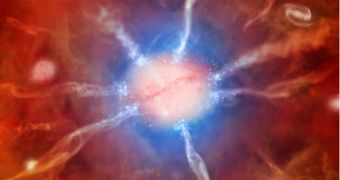In a study that used 10 of the world's best telescopes, astronomers were able to discover a galaxy cluster that breaks several cosmic records at the same time. Known as the Phoenix Cluster, the structures is one of the largest in the known Universe.
The cluster was discovered using the NASA Chandra X-ray Observatory (CXO), the US National Science Foundation's (NSF) South Pole Telescope. Additional data were provided by the European Space Agency's (ESA) Herschel Space Observatory.
Optical wavelength data from the ground-based Gemini Observatory, the Blanco 4-meter telescope, and the Magellan telescope, in Chile, were also used. Space-based observations were conducted using NASA's Wide-field Infrared Survey Explorer (WISE) and Galaxy Evolution Explorer (GALEX).
The recent series of observations may force astronomers to change their interpretations of how galaxies, and the clusters they form, evolve over time. According to available data, the cluster is producing new stars at a frantic pace, the highest ever found at the core of such a structure.
Observing the object was very difficult, since it is located around 5.7 billion light-years from Earth. This means that we currently see what the object looked like when the Universe was less than half of its current age.
Full details of the study appear in the August 16 issue of the top scientific journal Nature. The lead author of the work is Michael McDonald, a Hubble Fellow at the Cambridge-based Massachusetts Institute of Technology (MIT).
“While galaxies at the center of most clusters may have been dormant for billions of years, the central galaxy in this cluster seems to have come back to life with a new burst of star formation. The mythology of the Phoenix, a bird rising from the dead, is a great way to describe this revived object,” he says.
The vast gas reservoir inside the Phoenix Cluster contains more normal (baryonic) matter than dark matter. This unusual occurrence is largely what allows it to form so many new stars so fast.
Astrophysicists believe that we are observing this cluster at a relatively short-lived period when both the central galaxies and their supermassive black holes are adding mass very fast. Soon, the feedback mechanisms tying the two together will prevent them from continuing this fast growth.
“This spectacular star burst is a very significant discovery because it suggests we have to rethink how the massive galaxies in the centers of clusters grow. The cooling of hot gas might be a much more important source of stars than previously thought,” comments Martin Rees.
The scientist, a world-renowned expert on cosmology at the Cambridge University, was not a part of the new investigation.

 14 DAY TRIAL //
14 DAY TRIAL //